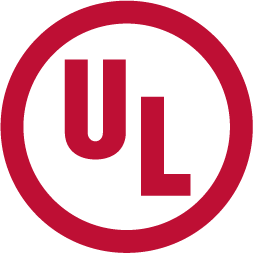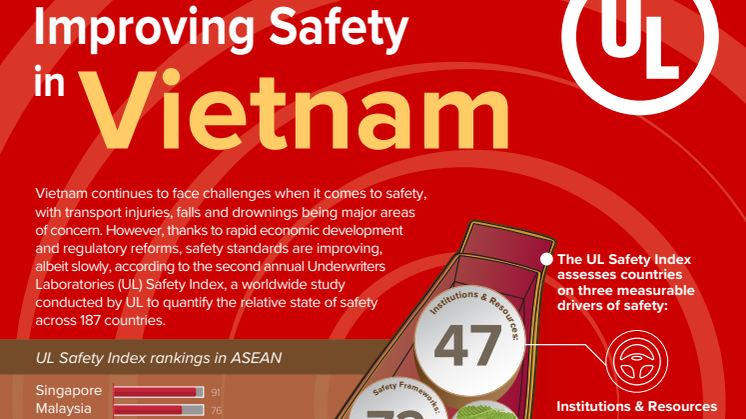Press release -
Vietnam climbs the ranks of UL Safety Index™
HO CHI MINH CITY, April 18, 2018 — Vietnam is becoming a safer nation relative to many others, and once again improved its safety ranking in 2017. This is according to a report by UL (Underwriters Laboratories), a global safety science company, which unveiled an update to its UL Safety Index™ and provided an in-depth analysis of the state of safety in Vietnam. Among the new aspects of the latest UL Safety Index™ is the inclusion of additional data sets, including road safety.
The UL Safety Index™ provides a snapshot of a country’s relative safety performance based on three measurable drivers of safety: institutional drivers (e.g. economics and education), safety frameworks (current regulations and safety infrastructure) and safety outcomes (unintentional injuries and deaths). Each of the 187 countries received an overall Safety Index assessment number between zero and 100.
The Netherlands and Norway, followed by Australia, Sweden and Canada, had the highest overall UL Safety Index™ values, while Denmark, Singapore, Germany and the United States’ values fell. Vietnam moved up eleven places in the UL Safety Index™ and currently ranks 76th. This places Vietnam squarely in the middle tier of countries in Southeast Asia. In Vietnam, overall injury rates notably decreased, with drowning deaths falling by fifteen percent, poisoning by fourteen percent and transport deaths by eight percent over the year 2017.
“Our mission is to help advance safe living and working environments for people in Vietnam, and around the world, and to contribute to the discourse on public health and safety,” said David Wroth, Director, Data Science – Underwriters Laboratories. “The findings from the study this year illustrate that Vietnam is performing better in its overall efforts to improve safety. Our aim is to contribute to decision-making about safety issues by Vietnamese policy makers and other stakeholders, and to support the identification of investment priorities for improving safety levels.”
Vietnam’s Relative Safety on the Rise
The latest UL Safety Index™ findings point to a few indicators that have contributed to Vietnam’s relative improvement. First, Vietnam’s strong economic growth has continued to help improve public health and safety. The country’s GDP per capita improved by twelve points, and much has been reinvested into better infrastructure and programs. As individual incomes have risen, Vietnamese citizens can also afford higher-quality and safer products.
In addition, Vietnam’s education standards have improved significantly since the year 2000. Given that education is a key component of the institutional driver measurement of the UL Safety Index™, progress in this area has contributed to increased safety levels in Vietnam. Efforts by the Vietnamese government to improve education, such as the recent Higher Education Renovation Project, have contributed to this accomplishment. Lastly, Vietnam also improved on its technology utilization to better manage public safety, identify hazards, communicate about intervention programs and reduce fatalities.
Opportunities for Improvement in Vietnam
As the country continues to progress, there are still opportunities to further enhance safety and perform even better in future. Specific actions to improve safety performance include addressing the rate of drowning incidents, falls among the elderly population, and transport injuries, where Vietnam ranks among the lowest tier of countries in Asia.
The UL Safety Index™ reported that road traffic injuries, including pedestrian, motorcycle and truck crashes, account for the vast majority of transport injuries in Vietnam and around the world. In Vietnam, specifically, a large portion of fatal road crashes involve motorcycles. While the enforcement of its national motorcycle helmet law is considered exemplary, there are indications that additional efforts can be made to improve safety on Vietnam’s roads, such as improving vehicle safety standards or enforcement laws for various driving conditions.
Global UL Safety Index™ Highlights
Globally, key highlights from the latest UL Safety Index™ include:
- Among all factors, institutional drivers, such as economic and educational levels, had the greatest impact on overall UL Safety Index™ values. For example, while India has moderately high safety frameworks in place (greater than 73), its lack of strong institutions and resources (less than 43) brought down its overall UL Safety Index™ value to 63.
- Overall, Japan had the highest UL Safety Index™ value (89) of all countries in the East Asian region, with the lowest rates of transport injuries and poisonings.
- The United States maintained a strong overall safety value of 89 – slightly less than last year’s value of 91. The U.S. garnered a value of 69 for road safety frameworks, behind countries like Malaysia, Finland and Argentina.
“With road traffic crashes as the single largest cause of unintentional injuries and deaths around the world, we felt it was imperative to include an indicator to measure road safety efforts,” said Wroth. “Safety truly is a system where multiple moving parts play a role, and the outcomes of our research demonstrate how each part is interconnected. We look forward to seeing continued progress in safety outcomes in Vietnam and around the world.”
For access to the updated UL Safety Index™, including background on the Index’s methodology, visit www.ULSafetyIndex.org.
Related links
Topics
- Social issues
Categories
- ho chi minh
- vietnam
- ul
- safety
- ul safety index
About UL
UL fosters safe living and working conditions for people everywhere through the application of science to solve safety, security and sustainability challenges. The UL Mark engenders trust enabling the safe adoption of innovative new products and technologies. Everyone at UL shares a passion to make the world a safer place. We test, inspect, audit, certify, validate, verify, advise and train and we support these efforts with software solutions for safety and sustainability. To learn more about us, visit UL.com.

